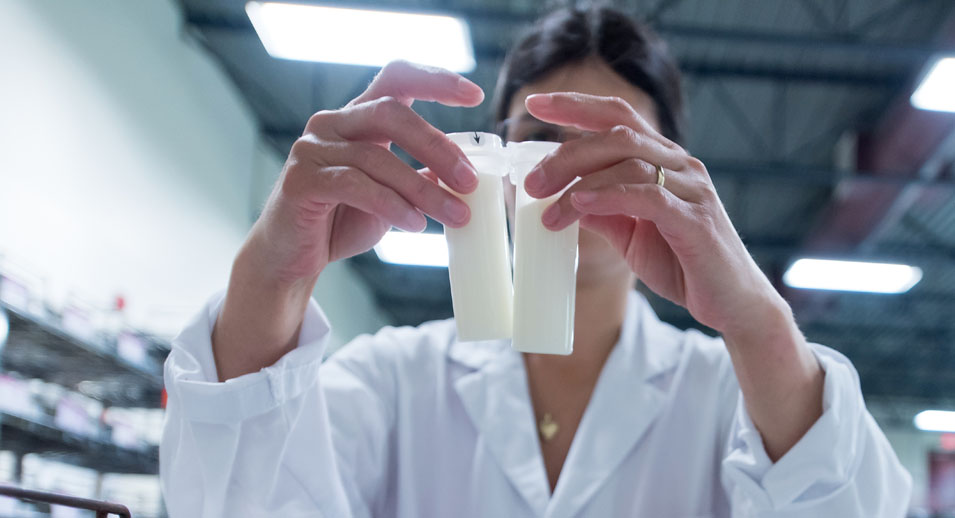Monitoring Grass-Fed Status of Dairy Herds by Routine Analysis of Bulk Tank Milk Samples
- March 30, 2023
Lactanet is working on a project that would save the costs of the gas chromatography (GC) analysis for producers who wish to implement the grass-fed standard.

In 2019, Dairy Farmers of Canada (DFC) released a standard to produce milk from grass-fed cows.
The standard stipulates that grass or forages must constitute at least 75% of dry matter intake throughout the year, while the rest can be supplements and grains including, corn silage.
The contribution of corn silage to the ration is assumed to be 50% as forage and 50% as grain unless lab analysis indicates otherwise. In addition, cows must spend at least 120 days per year grazing for 6 hours per day on an area larger than 0.13 hectare per animal during the grazing season, if possible.
To verify the authenticity of produced milk, grass-fed producers are subjected to routine audits and they are required to demonstrate that the ratio between linoleic acid (LA), an omega 6 fatty acid, to α-linolenic acid (ALA), an omega 3 fatty acid, in milk produced by their grass-fed herd is less than or equal to 3.5 for the first 12 months of certification and less than or equal to 3 thereafter.
To do so, bulk milk tank samples must be analyzed by gas chromatography (GC) at least six times per year, which can be considerably costly.
New Monitoring System
To provide an affordable alternative to the GC analysis for dairy producers who wish to implement this standard, Lactanet conducted a pilot project in 2019-2020 to investigate the possibility of determining the LA:ALA ratio from bulk tank payment samples by the milk analyzers in Lactanet’s labs. This analysis already provides multiple milk traits to producers, and it is significantly cheaper than the GC one.
The encouraging results of the pilot project paved the way for a project on a bigger scale, which was conducted in 2021-2023 to develop a monitoring system to authenticate milk produced from grass-fed herds. The corner stone of this system will be a model that will predict the LA:ALA ratio from bulk tank payment samples that are routinely collected from dairy producers.
In this project, 27 grass-fed herds and 13 conventional ones from 3 Canadian provinces (Québec, Ontario, and Nova Scotia) contributed monthly bulk tank milk samples and ration information from June 2021 to September 2022.
Major milk components, 74 fatty acids and LA:ALA ratio were determined for the collected samples. Several algorithms were evaluated for their ability to authenticate grass-fed milk from bulk tank payment samples. One of these algorithms, partial least squares regression, proved to be the most robust one in predicting LA:ALA ratio, especially when frequent measurements over a specific period were averaged.
Some Interesting Observations
When milk composition data were analyzed, two interesting points were observed.
1. Threshold to be optimized
First, we noticed that LA:ALA ratios for multiple conventional herds were frequently below 3 throughout the year even though nothing in those herds rations indicated that they were being grass-fed.
Biomarker analysis of the LA:ALA values suggested that the current threshold of 3 might not be the optimum one to differentiate between conventional and grass-fed herds and it might need to be lowered to increase LA:ALA ratio’s ability to reject conventionally produced milk for not being grass-fed milk; hence, improving the ability of the LA:ALA ratio to differentiate between the two types of milk.
2. More biomarkers need to be further investigated
The second point that was noted was about the adequacy of having just one biomarker to authenticate grass-fed milk and whether we should be looking for other ones for this purpose. To search for other such biomarkers, selected samples from fall and spring were subjected to elaborate chemical analysis and 60 metabolites were determined.
Data analysis of the results revealed 13 metabolites that were significantly different between milk produced from grass-fed and conventional herds. Multiple metabolites among these could be traced back to molecules that originated in either grass or concentrates that were administered to cows. This observation suggests that more biomarkers need to be further investigated to assess their capabilities to authenticate milk produced from grass-fed herds.
In summary, the current recognized biomarker that is used for authentication purposes of milk produced from grass-fed herds is the LA:ALA ratio and our recent project showed that the value of this ratio can be predicted from the payment milk samples analyzed in Lactanet’s lab with reasonable accuracy to save the producers, who wish to implement the grass-fed standard, the costs of the GC analysis.
In addition, there are other molecules present in milk that can be traced back to the type of the administered ration and whose concentrations differed significantly between the two types of milk.
Another important lesson that was learnt from this project is that milk samples that we routinely collect from dairy producers contain untapped information that can provide new insights when those samples are subjected to more elaborate chemical analysis and more advanced data analysis techniques.

This project is funded through the “Programme de développement sectoriel” under the Canadian Agricultural Partnership, an agreement between the governments of Canada and Quebec.
We thank Dairy Farmers of Canada (DFC), Producteurs de lait du Québec (PLQ) and Dairy Farmers of Ontario (DFO) for their financial support for this project.










